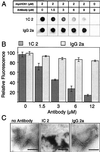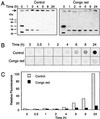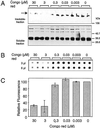Inhibition of huntingtin fibrillogenesis by specific antibodies and small molecules: implications for Huntington's disease therapy
- PMID: 10829068
- PMCID: PMC18723
- DOI: 10.1073/pnas.110138997
Inhibition of huntingtin fibrillogenesis by specific antibodies and small molecules: implications for Huntington's disease therapy
Abstract
The accumulation of insoluble protein aggregates in intra and perinuclear inclusions is a hallmark of Huntington's disease (HD) and related glutamine-repeat disorders. A central question is whether protein aggregation plays a direct role in the pathogenesis of these neurodegenerative diseases. Here we show by using a filter retardation assay that the mAb 1C2, which specifically recognizes the elongated polyglutamine (polyQ) stretch in huntingtin, and the chemical compounds Congo red, thioflavine S, chrysamine G, and Direct fast yellow inhibit HD exon 1 protein aggregation in a dose-dependent manner. On the other hand, potential inhibitors of amyloid-beta formation such as thioflavine T, gossypol, melatonin, and rifampicin had little or no inhibitory effect on huntingtin aggregation in vitro. The results obtained by the filtration assay were confirmed by electron microscopy, SDS/PAGE, and MS. Furthermore, cell culture studies revealed that the Congo red dye at micromolar concentrations reduced the extent of HD exon 1 aggregation in transiently transfected COS cells. Together, these findings contribute to a better understanding of the mechanism of huntingtin fibrillogenesis in vitro and provide the basis for the development of new huntingtin aggregation inhibitors that may be effective in treating HD.
Figures






Similar articles
-
Identification of benzothiazoles as potential polyglutamine aggregation inhibitors of Huntington's disease by using an automated filter retardation assay.Proc Natl Acad Sci U S A. 2002 Dec 10;99 Suppl 4(Suppl 4):16400-6. doi: 10.1073/pnas.182426599. Epub 2002 Aug 28. Proc Natl Acad Sci U S A. 2002. PMID: 12200548 Free PMC article.
-
Human single-chain Fv intrabodies counteract in situ huntingtin aggregation in cellular models of Huntington's disease.Proc Natl Acad Sci U S A. 2001 Apr 10;98(8):4764-9. doi: 10.1073/pnas.071058398. Proc Natl Acad Sci U S A. 2001. PMID: 11296304 Free PMC article.
-
Reversal of a full-length mutant huntingtin neuronal cell phenotype by chemical inhibitors of polyglutamine-mediated aggregation.BMC Neurosci. 2005 Jan 13;6:1. doi: 10.1186/1471-2202-6-1. BMC Neurosci. 2005. PMID: 15649316 Free PMC article.
-
[Huntington disease. A review].Invest Clin. 2000 Jun;41(2):117-41. Invest Clin. 2000. PMID: 10961047 Review. Spanish.
-
Challenges of Huntington's disease and quest for therapeutic biomarkers.Proteomics Clin Appl. 2015 Feb;9(1-2):147-58. doi: 10.1002/prca.201400073. Epub 2014 Nov 2. Proteomics Clin Appl. 2015. PMID: 25290828 Review.
Cited by
-
Melatonin antioxidative defense: therapeutical implications for aging and neurodegenerative processes.Neurotox Res. 2013 Apr;23(3):267-300. doi: 10.1007/s12640-012-9337-4. Epub 2012 Jun 28. Neurotox Res. 2013. PMID: 22739839 Review.
-
Assay strategies for identification of therapeutic leads that target protein trafficking.Trends Pharmacol Sci. 2015 Aug;36(8):498-505. doi: 10.1016/j.tips.2015.05.004. Epub 2015 Jun 8. Trends Pharmacol Sci. 2015. PMID: 26067100 Free PMC article. Review.
-
The use of the R6 transgenic mouse models of Huntington's disease in attempts to develop novel therapeutic strategies.NeuroRx. 2005 Jul;2(3):447-64. doi: 10.1602/neurorx.2.3.447. NeuroRx. 2005. PMID: 16389308 Free PMC article. Review.
-
Polyglutamine fibrillogenesis: the pathway unfolds.Proc Natl Acad Sci U S A. 2003 Jan 7;100(1):1-3. doi: 10.1073/pnas.0237018100. Epub 2002 Dec 30. Proc Natl Acad Sci U S A. 2003. PMID: 12509507 Free PMC article. No abstract available.
-
Transitioning pharmacoperones to therapeutic use: in vivo proof-of-principle and design of high throughput screens.Pharmacol Res. 2014 May;83:38-51. doi: 10.1016/j.phrs.2013.12.004. Epub 2013 Dec 25. Pharmacol Res. 2014. PMID: 24373832 Free PMC article. Review.
References
-
- Harper P S. Huntington's Disease. Philadelphia: Saunders; 1991.
-
- Vonsattel J-P, Meyers R H, Stevens T J, Ferrante R J, Bird E D, Richardson E P. J Neuropathol Exp Neurol. 1985;44:559–577. - PubMed
-
- Scherzinger E, Lurz R, Turmaine M, Mangiarini L, Hollenbach B, Hasenbank R, Bates G P, Davies S W, Lehrach H, Wanker E E. Cell. 1997;90:549–558. - PubMed
-
- Davies S W, Trumaine M, Cozens B A, DiFiglia M, Sharp A H, Ross C A, Scherzinger E, Wanker E E, Mangiarini L, Bates G P. Cell. 1997;90:537–548. - PubMed
-
- Warrick J M, Paulson H L, Gray-Board G L, Bui Q T, Fischbeck K H, Pittman R N, Bonini N M. Cell. 1998;93:939–949. - PubMed
Publication types
MeSH terms
Substances
LinkOut - more resources
Full Text Sources
Other Literature Sources
Medical

